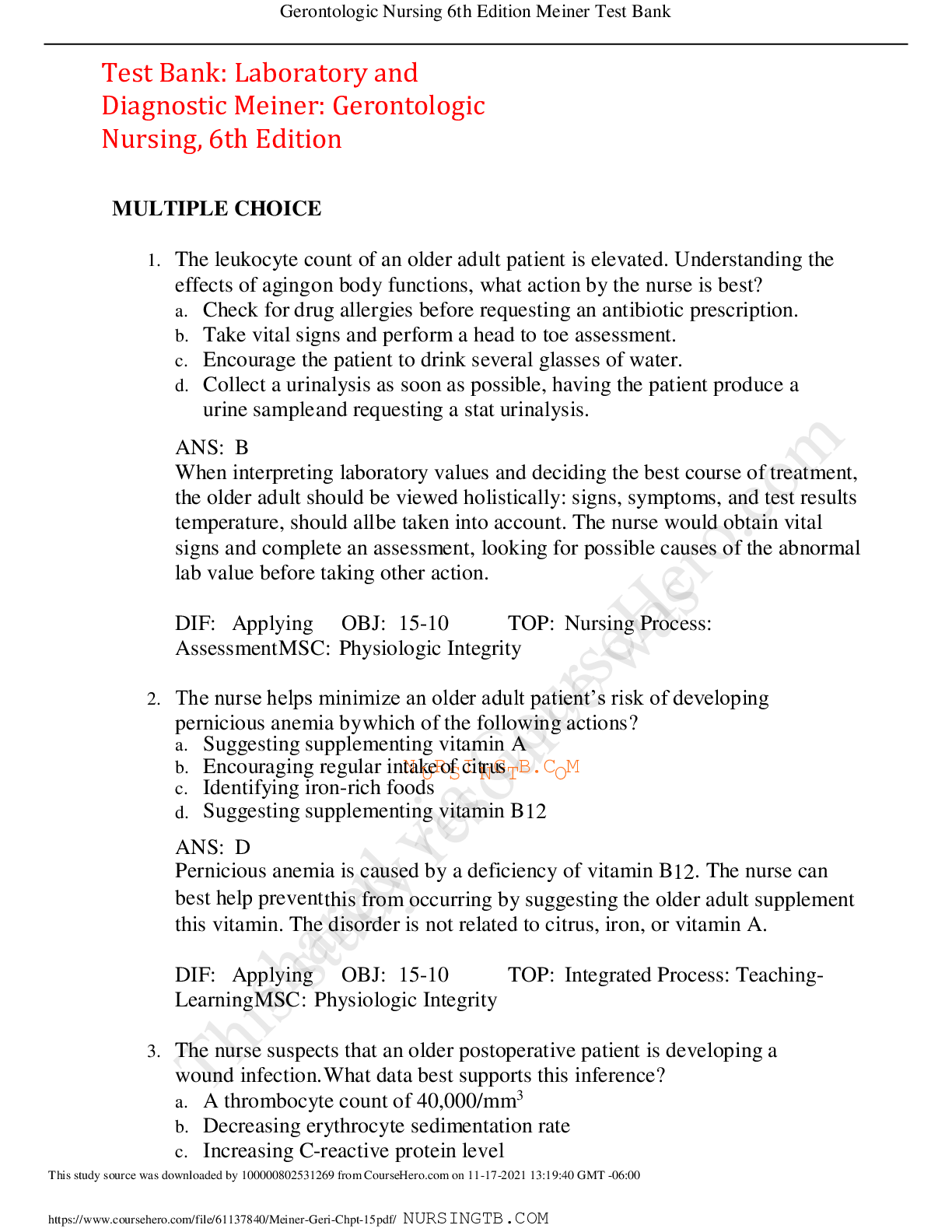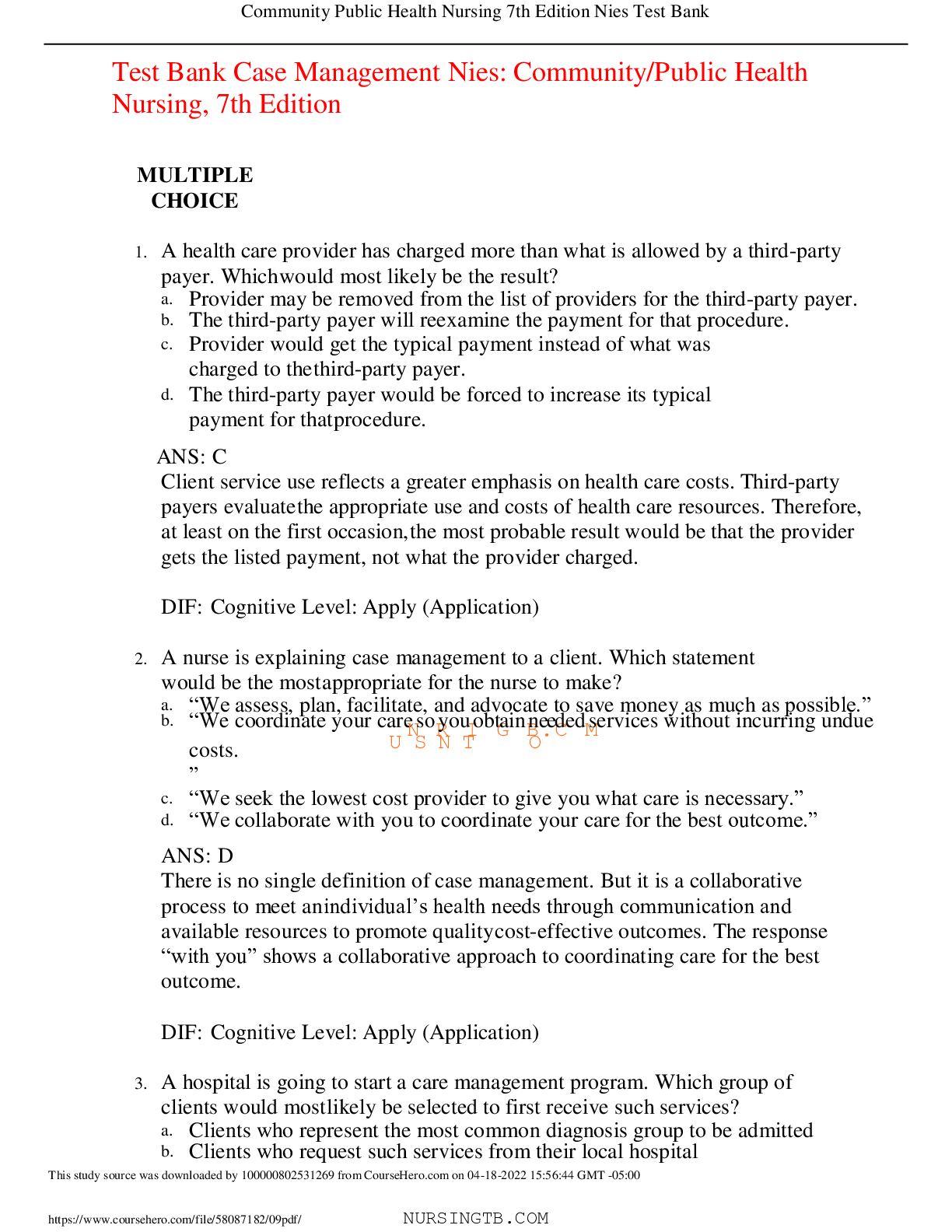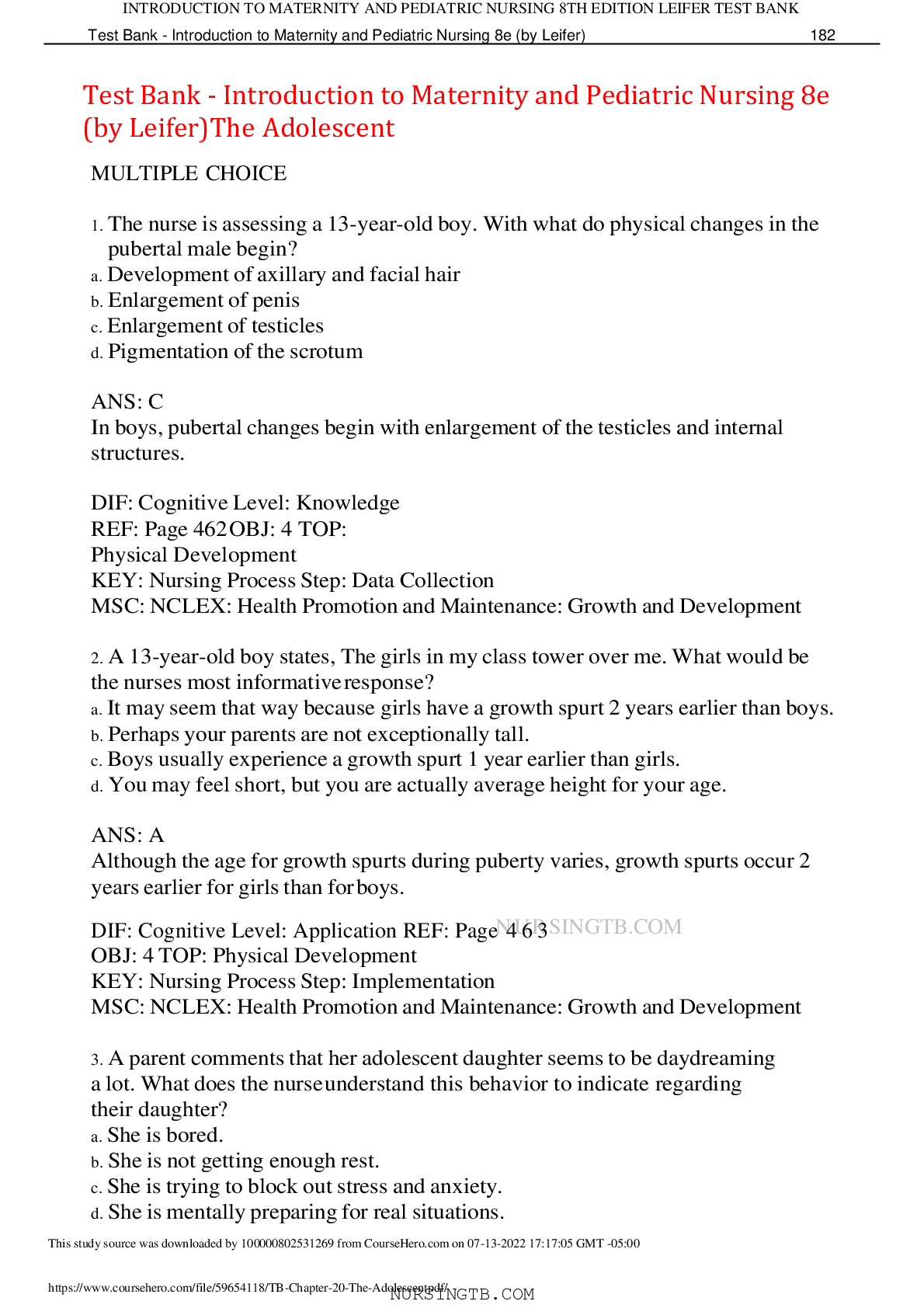*NURSING > TEST BANK > Test Bank: Antiparkinsonian Drugs Keltner: Psychiatric Nursing, 8th Edition,100% CORRECT (All)
Test Bank: Antiparkinsonian Drugs Keltner: Psychiatric Nursing, 8th Edition,100% CORRECT
Document Content and Description Below
Test Bank: Antiparkinsonian Drugs Keltner: Psychiatric Nursing, 8th Edition MULTIPLE CHOICE 1. A psychiatric nurse should base care of patients diagnosed with Parkinson disease and patients de... monstrating extrapyramidal side effects (EPSEs) caused by antipsychotic drug therapy on what premise concerning symptoms? a. Both conditions share similar symptoms. b. Both sets of symptoms result from deficits in dopamine synthesis. c. Both sets of symptoms result from acetylcholine and dopamine imbalance. d. All associated symptoms are produced by neurodegeneration of the substantia nigra. ANS: C In both problems, acetylcholine and dopamine are not in balance. In Parkinson disease, this results from neurodegeneration of the substantia nigra, and in the case of EPSEs, the cause is blockade of dopamine receptors in the basal ganglia. The other options are not valid premises. DIF: Cognitive level: Understanding TOP: Nursing process: Planning MSC: Client Needs: Physiologic Integrity 2. A patient who is receiving an antipsychotic drug is restless, paces, and cannot sit still when watching television. The nurse should use which term to document these findings? a. Dystonia b. Akathisia c. Dyskinesia d. Bradykinesia ANS: B NURSINGTB.COM A patient with akathisia describes feeling restless, jittery, and unable to sit, and has restless legs that feel better only if the patient is moving. Dystonia refers to sustained, twisted muscle contractions. Dyskinesia refers to jerky motions. Bradykinesia refers to slow movement. DIF: Cognitive level: Understanding TOP: Nursing process: Implementation MSC: Client Needs: Physiologic Integrity 3. A patient who is receiving an antipsychotic drug is restless, paces, and cannot sit still when watching television. The patient says, “I couldn’t sleep last night because I needed to pace.” What is the expected intervention by the patient’s primary health care provider? a. A prescription for an anticholinergic drug b. Discontinuation of the antipsychotic drug c. A prescription for a dopaminergic medication. d. A prescription for a bedtime antihistamine to promote sleep. ANS: A The patient’s motor symptoms can be assessed as akathisia. Anticholinergic medication provides relief for some patients. The nurse should report the patient’s symptoms to the health care provider and anticipate the order to begin anticholinergic therapy. The other options do not provide acceptable alternatives. DIF: Cognitive level: Understanding TOP: Nursing process: Implementation MSC: Client Needs: Physiologic Integrity 4. A patient who has taken three doses of haloperidol suddenly cries out for help. The nurse observes that the patient’s eyes are rolled upward in a fixed gaze. The nurse should document this behavior using what term? a. Akathisia b. Nystagmus c. Tardive dyskinesia d. Oculogyric crisis ANS: D Oculogyric crisis is a specific dystonia in which the eyes roll upward and remain in a fixed position. It results from involuntary muscle spasms and occurs early in the course of treatment. Akathisia refers to motor restlessness. Nystagmus refers to a different type of abnormal eye movements. Tardive dyskinesia refers to abnormal movements primarily of the face and mouth muscles. DIF: Cognitive level: Understanding TOP: Nursing process: Assessment MSC: Client Needs: Physiologic Integrity 5. A patient who has taken three doses of haloperidol suddenly cries out for help. The nurse observes that the patient’s eyes are rolled upward in a fixed gaze. The nurse should administer which drug from the patient’s PRN list? a. Vitamin E b. Carbidopa c. Benztropine d. Amantadine ANS: C NURSINGTB.COM Benztropine is an anticholinergic that can be given orally or parenterally in case of an emergency, such as oculogyric crisis or dystonic reaction. The other options would not relieve the dystonia. DIF: Cognitive level: Applying TOP: Nursing process: Implementation MSC: Client Needs: Physiologic Integrity 6. A patient has taken perphenazine for a year. The nurse observes lip smacking and grinding teeth. Which tool should the nurse use to complete the client’s assessment? a. AIMS b. EPSE c. SAD PERSONS d. CAGE ANS: A AIMS is the Abnormal Involuntary Movement Scale. It was developed to screen for tardive dyskinesia. EPSE refers to extrapyramidal side effects. The other tools are for assessing alcohol abuse and suicidality. DIF: Cognitive level: Understanding TOP: Nursing process: Planning MSC: Client Needs: Physiologic Integrity 7. Which symptom of Parkinson disease has the highest priority for nursing intervention? a. Tremor b. Akathisia c. Dysphagia d. Tardive dyskinesia ANS: C Dysphagia is difficulty swallowing. Because dysphagia can lead to a compromised airway, it is the priority symptom among those listed. DIF: Cognitive level: Analyzing TOP: Nursing process: Assessment MSC: Client Needs: Physiologic Integrity 8. The nurse caring for a patient receiving a dopaminergic drug should assess the individual for early symptoms of what schizophrenia-associated condition? a. Psychosis b. Fluid imbalance c. Tardive dyskinesia d. Labile hypertension ANS: A Dopamine excess is associated with schizophrenia. When dopaminergic drugs are given, symptoms of psychosis might appear or be exacerbated. Tardive dyskinesia is associated with dopamine deficiency. The other options are unrelated to the medication or to schizophrenia. DIF: Cognitive level: Applying TOP: Nursing process: Assessment MSC: Client Needs: PhysiologNicUInRteSgrIityNGTB.COM 9. Which statement by the nurse indicates an understanding of the safe and effective administration of an anticholinergic medication? a. “Avoid eating foods high in tyramine.” b. “Do not abruptly stop taking the drug.” c. “Take oral medications on an empty stomach.” d. “Take a multivitamin and mineral supplement daily.” ANS: B Tapering off the drug over a 1-week period is advisable instead of abruptly stopping the drug. This prevents uncomfortable withdrawal symptoms. Avoiding foods high in tyramine is important teaching for patients taking monoamine oxidase inhibitors (MAOIs). The other statements are not applicable to this classification of medications. DIF: Cognitive level: Applying TOP: Nursing process: Implementation MSC: Client Needs: Physiologic Integrity 10. A patient began trihexyphenidyl therapy for treatment of drug-induced parkinsonism. Which finding demonstrates a positive response to the medication? a. Blood pressure returns to patient’s normal range. b. Gait is steady with decreased rigidity. c. Patient reports fewer feelings of depression. d. Patient has tremors with voluntary movement. ANS: B Gait disturbance, tremor, bradykinesia, and rigidity are symptoms of drug-induced parkinsonism. Reduction in these symptoms constitutes a positive outcome. The other options are not expected outcomes. DIF: Cognitive level: Understanding TOP: Nursing process: Evaluation MSC: Client Needs: Physiologic Integrity 11. When developing a teaching plan for a patient receiving benztropine, what is a priority nursing consideration? a. Anticholinergic drugs often cause blurred vision. b. Urinary frequency may impair the patient’s concentration. c. Akathisia produced by the drug will make concentration difficult. d. Increased peristalsis might cause gastrointestinal distress and impair concentration. ANS: A CNS effects include confusion, drowsiness, and decreased memory and learning. This might affect the patient’s ability to learn. Anticholinergics do not cause urinary frequency, akathisia, or increased peristalsis. DIF: Cognitive level: Understanding TOP: Nursing process: Planning MSC: Client Needs: Physiologic Integrity 12. A patient prescribed haloperidol for a diagnosis of schizophrenia has a dystonic reaction. Benztropine 2 mg is given intramuscularly and then continued orally twice daily. Three days later, the patient has fever, disorientation, and tachycardia. What is the most likely cause of the latest signs and symptoms? a. Tardive dyskinesia has emNeUrgReSd.INGTB.COM b. Benztropine toxicity has developed. c. Extrapyramidal symptoms have returned. d. Dopaminergic benztropine effects have exacerbated the psychosis. ANS: B CNS hyperstimulation from anticholinergics causes fever, disorientation, excitement, agitation, delirium, and hallucinations as well as cardiovascular, urinary, and gastrointestinal symptoms. Collectively, these findings indicate anticholinergic toxicity. The symptoms described in the scenario do not accurately reflect any of the other options. DIF: Cognitive level: Analyzing TOP: Nursing process: Evaluation MSC: Client Needs: Physiologic Integrity 13. An older adult patient who takes trihexyphenidyl begins taking diphenhydramine (Benadryl) for cold symptoms. The nurse should carefully monitor this patient for what possible anticholinergic effect? a. Polyuria b. Tachycardia c. Constipation d. Hypothermia ANS: B An anticholinergic effect on the vagus nerve causes tachycardia by removing the braking effect on the sinoatrial node. The additive effects of trihexyphenidyl and diphenhydramine would be likely to produce tachycardia, which could lead to cardiac decompensation in an older adult. In terms of priority of problems, hyperthermia may occur later, after toxic levels of anticholinergics had been ingested; constipation would be less life-threatening than cardiac decompensation. Anticholinergics cause urinary retention, not polyuria. DIF: Cognitive level: Applying TOP: Nursing process: Assessment MSC: Client Needs: Physiologic Integrity 14. The nurse providing patient teaching regarding an anticholinergic drug demonstrates an understanding of this classification of medication by including what instruction? a. Limiting fluid intake to 1000 mL/day b. Limiting strenuous activity on hot days c. Eating small, frequent meals to decrease nausea d. Wearing adequate clothing to prevent hypothermia ANS: B An anticholinergic side effect is decreased sweating. Sweating produces body cooling through evaporation. Heat stroke is a greater possibility when the body cannot cool itself. The other options have no particular relevance to anticholinergic therapy. DIF: Cognitive level: Applying TOP: Nursing process: Evaluation MSC: Client Needs: Physiologic Integrity 15. Which patient receiving fluphenazine should be monitored most closely for extrapyramidal side effects (EPSEs)? a. 35-year-old man b. 45-year-old woman c. 74-year-old woman NURSINGTB.COM d. Patient diagnosed with chronic schizophrenia ANS: C Women, older adults, patients with affective symptoms, and patients with first episodes of schizophrenia have a higher risk for EPSEs. DIF: Cognitive level: Analyzing TOP: Nursing process: Assessment MSC: Client Needs: Physiologic Integrity 16. An elderly nursing home resident has been diagnosed with type 2 diabetes, hypertension, and dementia. The patient begins taking an antipsychotic drug for agitation. Tremor and bradykinesia develop, so an anticholinergic is added to the drug regimen. Within 3 days, the patient displays a marked cognitive deficit. Which medication is the most likely cause of the cognitive change? a. Antihypertensive b. Anticholinergic c. Antipsychotic d. Antidiabetic ANS: B Anticholinergic medications often produce cognitive changes in older adults. Although the other medications listed might produce untoward effects, because the symptoms appeared after the introduction of the anticholinergic, one would suspect this drug first. DIF: Cognitive level: Analyzing TOP: Nursing process: Evaluation MSC: Client Needs: Physiologic Integrity 17. Of the patients the nurse will see at the mental health center, which one should be assessed most carefully for extrapyramidal side effects (EPSEs)? a. 59-year-old man with a 20-year history of severe mental who is prescribed olanzapine. b. 18-year-old woman experiencing a first episode of schizophrenia who is prescribed haloperidol. c. 26-year-old man diagnosed with generalized anxiety disorder who is prescribed lorazepam. d. 30-year-old woman diagnosed with depression who is prescribed amitriptyline. ANS: B Risk factors for EPSEs include female gender, first episode of schizophrenia, older adults and people diagnosed with an affective disorder. The other patients are at lower or no risk because of taking an atypical antipsychotic, a tricyclic antidepressant, and an antianxiety drug. DIF: Cognitive level: Analyzing TOP: Nursing process: Assessment MSC: Client Needs: Physiologic Integrity 18. Which medication from a patient’s pharmacologic profile is most likely to precipitate neuroleptic malignant syndrome (NMS)? a. Diphenhydramine b. Risperidone c. Haloperidol d. Clozapine ANS: C NURSINGTB.COM Haloperidol is a first-generation high-potency antipsychotic drug. It has a greater risk for producing NMS than atypical antipsychotic drugs. Diphenhydramine is not an antipsychotic drug. DIF: Cognitive level: Understanding TOP: Nursing process: Assessment MSC: Client Needs: Physiologic Integrity 19. Which neurotransmitter is most affected by an anticholinergic drug? a. Acetylcholine b. Dopamine c. Serotonin d. GABA ANS: A Anticholinergic drugs inhibit acetylcholine, thereby preventing stimulation of the cholinergic excitatory pathways. The other neurotransmitters are associated with the etiology of schizophrenia, anxiety, and depression. DIF: Cognitive level: Understanding TOP: Nursing process: Assessment MSC: Client Needs: Physiologic Integrity MULTIPLE RESPONSE 1. When patients are treated with antipsychotic medications, a variety of side effects and adverse reactions may occur. Which possible reaction presents the highest risk for patient injury? (Select all that apply.) a. Akathisia b. Dystonic reaction c. Neuroleptic malignant syndrome (NMS) d. Tardive dyskinesia ANS: A, B, C, D NMS is considered a medical emergency requiring immediate intervention to save the patient’s life. A dystonic reaction is extremely uncomfortable and requires swift intervention to restore patient comfort. Akathisia is uncomfortable but is not considered an emergency. Tardive dyskinesia is a serious, possibly unremitting problem that might require discontinuing the medication. It develops over weeks, months, or years. DIF: Cognitive level: Analyzing TOP: Nursing process: Planning MSC: Client Needs: Physiologic Integrity 2. A patient diagnosed with Parkinson disease begins levodopa therapy. What outcome should the nurse expect from levodopa therapy? a. Improvement of associated symptoms related to the increase of dopamine b. Improvement of associated symptoms related to the decrease levels of GABA c. Reduction of any existingNdeRpresIsionG B.C M d. Reduction in the risk of dysphagia e. Reduction in the risk of falls associated with an unsteady gait ANS: A Levodopa is converted to dopamine in the central nervous system (CNS), so its administration will cause a reduction in the symptoms of Parkinson disease related to dopamine deficiency. Levodopa increases dopamine levels. Levodopa will improve the patient’s swallowing ability and gait, and will reduce symptoms of depression. Levodopa is not associated with changes in gamma-aminobutyric acid (GABA). DIF: Cognitive level: Applying TOP: Nursing process: Evaluation MSC: Client Needs: Physiologic Integrity [Show More]
Last updated: 1 year ago
Preview 1 out of 13 pages
Instant download

Instant download
Reviews( 0 )
Document information
Connected school, study & course
About the document
Uploaded On
Oct 18, 2021
Number of pages
13
Written in
Additional information
This document has been written for:
Uploaded
Oct 18, 2021
Downloads
0
Views
35






























